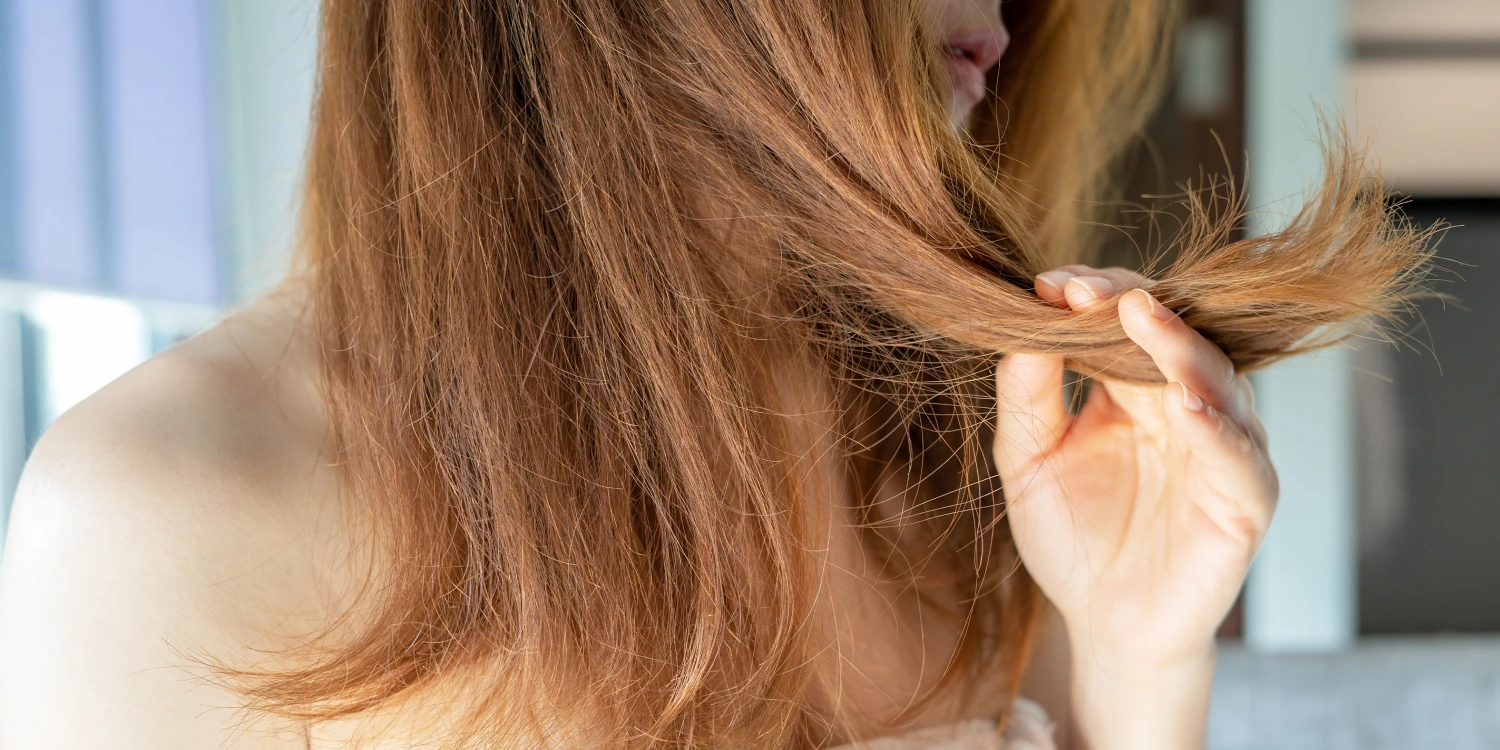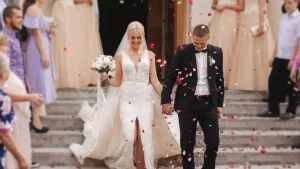Hair damage is a common concern. Environmental factors, styling habits, and lifestyle choices can all contribute to the weakening of our locks. The signs of damage can be disheartening, from split ends to brittle strands.
However, understanding the causes and implementing preventive measures can help restore and maintain the health of our hair.
Have you come to this article to know the causes of hair loss? Then this entire article is for you. Let’s explore the strategies and practices to safeguard our precious tresses from further harm.
The remarkable information about the Hair Damage
Here are the most remarkable insights from the article:
- Hair is a commonly disregarded emblem of health and beauty in day-to-day existence.
- Numerous variables, such as lifestyle choices, chemical treatments, heat styling, and environmental circumstances, can cause hair damage.
- Chemical processes such as perms, dyeing, and relaxers can lead to overprocessing and damage.
- Hair straightening irons and blow dryers are examples of appliances. It uses heat to weaken the structure of hair proteins.
- Environmental aggressors such as sun exposure, chlorine in swimming pools, and saltwater can weaken and fade hair color.
- Inadequate hair care techniques, such as excessive washing, the use of harsh shampoos, and very forceful styling, can result in damage.
- Medical conditions, including thyroid problems and nutritional deficiencies, might affect hair health.
- A holistic approach to hair health includes stress management, a balanced diet, and gentle hair care.
- Quick-fix hair regeneration treatments often overpromise, requiring perseverance and a well-thought-out plan.
- Gentle care may keep hair strong and vibrant while shielding it from injury.
What Causes Hair Damage?
The causes of hair loss need to be addressed to maintain healthy hair. The reasons behind hair loss are broken down as follows:
1. Environmental Factors
- Sun exposure, saltwater, and chlorine.
- UV rays weaken hair and fade color.
- Chlorine in pools dries hair.
2. Chemical Treatments
- Hair coloring, perms, relaxers.
- Ammonia and peroxide damage hair cuticles.
- Over-processing leads to dryness and breakage.
3. Heat Styling
- Blow dryers, straightening irons, curling wands.
- High temperatures weaken hair proteins.
- Overuse strips natural moisture and causes damage.
4. Hair Care Practices
- Excessive shampooing strips natural oils.
- Harsh shampoos may dry hair.
- Brushing/combing vigorously causes mechanical damage.
5. Lifestyle Factors
- Poor diet and nutritional deficiencies weaken hair.
- Stress can lead to hormonal changes.
- Medical conditions like thyroid disorders affect hair health.
These causes empower individuals to make informed choices and take proactive steps to prevent hair damage.
How Does Hair Structure Impact Damage?
How hair texture affects hair loss is essential to maintaining healthy locks. Below are some ideas to influence hair loss.
Here’s how hair structure contributes to damage:
- Complex Layers: Hair comprises multiple layers.
- Innermost Medulla: The medulla forms the innermost layer.
- Hair Shaft Strengthened by Cortex: The cortex offers elasticity and strength.
- Cuticle Guards External Layer: The cuticle serves as an external layer of defense.
- Maintaining Structure and Strength: Each layer plays a vital role.
- Vulnerability to Damage: Despite its complexity, hair is vulnerable.
- Assault from External Factors: External factors can breach defenses.
- Damage Shows Wear and Tear: Damage often manifests visibly.
- Need for Protection and Care: Protection and care are essential.
- Preventing Structural Compromise: Preventing damage ensures structural integrity.
- Understanding Hair Structure: Understanding is key to prevention.
- Holistic Hair Care: Holistic hair care takes structural demands into account.
Hair structure helps prevent damage. Taking preventative measures shields hair health.
How Can Hair Damage Be Prevented?
Preventing damage to the hair is necessary for maintaining strong, healthy hair.
The following guidance will assist you in protecting your hair:
- Choose gentle hair care products to shield your hair from harsh chemicals that might deplete it from its natural oils.
- Limit how much heat you use when styling: Overusing blow dryers, flat irons, and curling wands can weaken and damage hair.
- Avoid wearing tight hairstyles by using ponytails and braids frequently: Buns’ ability to stretch the hair shaft may result in hair loss and breakage.
- Cover your hair with a scarf or cap to shield it from the sun. After swimming, rinse your hair to remove chlorine and salt.
- Eat a balanced diet: Healthy hair development depends on nutrients like iron, zinc, and vitamins A, C, and E.
- Reduce your stress. Excessive stress can lead to hormonal imbalances that are detrimental to hair health.
- Use caution when combing and brushing. To avoid breaking hair, brush it with a wide-toothed comb rather than wet.
Following these tips, you can help avoid hair breakage and maintain the best-looking locks.
The Science of Hair Breakage
Each strand of hair is a wonder of natural engineering, composed generally of keratin. Nails, skin, and the outer layer of pores all contain the same protein.
Hair consists of the cuticle, which documents the outer layer of protection, the cortex, the innermost medulla, and other layers. Each is crucial to preserving the hair’s strength and structure.
It’s this complex tapestry that is underneath consistent assault from a variety of villains. There are many narratives about how these interlopers breach the fortress.
The strands that crown our heads aren’t impervious; they are vulnerable to the damage and tear that existence dishes out and regularly display the wear and tear before we do.
The Chemical Interference
Chemical treatments, while remodeling the advent of hair, place a heavy toll on its health. Hair coloring, using ammonia and peroxide, damage the cuticle, mainly due to dryness and breakage.
By changing hair’s natural bonds, perms and relaxers frequently bring about over-processed and substantially damaged hair. Similarly, chemical straighteners or Brazilian blowouts.
Though powerful for straightening, if misapplied, it could make hair brittle and liable to breakage. These remedies, regardless of their aesthetic blessings, can be detrimental to the general health of your hair.
The Trouble with Heat
Though handy, heat-styling equipment like blow dryers, straightening irons, and curling wands can seriously harm hair fitness.
Their high temperatures can harm the hair’s protein structure, resulting in weakness and breakage.
Overusing blow dryers can strip hair of its natural moisture, causing damage hazards. Improperly used or overheated flat irons and curling irons can scorch hair, making it brittle and at risk of breakage.
Environmental Aggressors
The surroundings are not kind to our hair. The sun’s effective UV rays can fade hair coloration and weaken hair. Meanwhile, salt water and chlorine could have comparable adverse effects.
- Sun Exposure: Prolonged sun exposure can cause the natural keratin in hair to deteriorate. Leading to a loss of structural integrity and an increase in porosity.
- Chlorine in Pools: Chlorine is a potent oxidizing agent frequently used to clean swimming pools. However, it is essential for maintaining public health. It may negatively impact hair, making it more dry and brittle.
- Salt Water: As the number of coastal vacations increases. So does the damage caused by salt water. It dehydrates the hair, which, if not thoroughly rinsed out, may result in breakage and a brittle texture.
Hair Care Missteps
From how you wash to the gear you operate to fashion, several practices initially seem harmless. But they might cause your hair to suffer gradually and quietly.
- Over-Washing: Excessive shampoo use can strip the hair of its natural oils, leaving it dry and more at risk of breakage.
- Harsh Shampoos: When used excessively frequently, certain shampoos, particularly those meant to clean the hair or treat dandruff, may be quite damaging and drying.
- Brushing and combing too much: Too much brushing or combing can mechanically harm the hair, causing splitting or cuticle damage if achieved with too much pressure or with the incorrect kind of tool.
- Tight Hairstyles: Continuously styling the hair in tight buns, ponytails, or braids can cause strain on the hair shaft and result in hair loss called traction alopecia.
Dietary Influence
Your diet affects your hair health. Consuming well-balanced meals encourages hair health. Mineral deficiency, such as low iron, zinc, vitamin A, C, and E levels, can weaken and break hair easily.
Excessive tension can bring on telogen effluvium, a condition marked by hormonal changes that lead to hair loss.
Medical Conditions and Medications
Certain medical conditions and their treatments affect hair health.
- Thyroid Disorders: Both hyperthyroidism and hypothyroidism can cause hair loss, making hair brittle or thin.
- Eating Disorders: Dietary deficits resulting from anorexia and bulimia might affect hair fitness.
- Autoimmune Diseases: The immune system can lead to hair loss, and autoimmune conditions like lupus and alopecia areata target hair follicles.
The Path to Reviving Your Mane
The road to hair revival is encumbered with strategic picks and knowledgeable choices. From deciding on the most gentle hair care merchandise to adopting a nourishing weight loss program, there are a multitude of procedures to rebuild and toughen your strands.
The Hair Regrowth Treatment Craze
The concept of Vitamins revive – hair regrowth treatment often guarantees greater than it gives you.
People are drawn to solutions that provide a quick restore, but the truth is that the path to hair recuperation is multi-faceted and often requires patience and time.
While topical and oral treatments can support common hair health, they need to be part of a complete routine that addresses both internal and external elements that contribute to hair harm.
Beyond Treatments: A Holistic Approach to Hair Health
Achieving healthy hair involves more than simply topical treatments. It requires a holistic approach that includes lifestyle alternatives.
A balanced weight-reduction plan rich in crucial nutrients from foods like salmon, avocados, and eggs supports scalp and hair fitness.
Managing stress through workouts, meditation, and other practices is vital for hormonal stability and hair increase.
Mild hair care practices, along with the use of moderate shampoos, avoid harsh chemical compounds. Heat and careful handling are key to maintaining hair’s energy and resilience.
In Conclusion
Your hair is a canvas that displays your inner health and well-being. It calls for care, persistence, and knowledge of factors contributing to its loss of life.
You can’t simply prevent damage by using a proactive hair care method. But you can revel in the whole, colorful texture that nature intended.
Your selections are the threads that lead you back to a nicely tended lawn of follicular resplendence in the labyrinth of hair damage. Treat your hair with the kindness and interest it deserves, for it’s your trusted partner on the odyssey of life.
FAQs about Causes of Hair Damage
Q1. What are the main causes of hair damage?
Hair damage can result from various factors, including environmental stressors like sun exposure and pollution, chemical treatments such as coloring or perming, heat styling tools like blow dryers and flat irons, and even certain hair care practices like overwashing or brushing too vigorously.
Q2. How does sun exposure damage hair?
Prolonged exposure to the sun’s ultraviolet (UV) rays can weaken the hair’s protein structure, leading to dryness, brittleness, and color fading.
Q3. What role do chemical treatments play in hair damage?
Chemical treatments like hair coloring, perming, and straightening can strip the hair of its natural oils and disrupt its protein bonds, resulting in dryness, breakage, and loss of elasticity.
Q4. How can heat styling tools cause hair damage?
Excessive use of heat styling tools can lead to overheating the hair shaft. Weakening its structure and causing split ends, breakage, and dullness.
Q5. Are certain hair care practices more damaging than others?
Yes, practices like overwashing, using harsh shampoos, and brushing or combing hair too vigorously can damage hair by stripping away natural oils, causing friction, and damaging the hair cuticle.
.webp)


